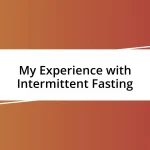Key takeaways:
- Understanding and addressing children’s emotions through non-verbal cues and direct conversations fosters better expression and management of their feelings.
- Engaging in mood-boosting activities tailored to each child’s interests, like outdoor play, creative expression, and family time, enhances emotional well-being.
- Establishing a consistent routine and incorporating mindfulness practices create a sense of stability and promote positive mental health for children.

Understanding Your Child’s Emotions
Understanding your child’s emotions can feel like deciphering a complex code. I remember one afternoon when my daughter burst into tears over a simple misunderstanding with a friend. Seeing her so distressed reminded me that even small issues can loom large in a child’s world. Have you ever noticed how their feelings can shift from joy to frustration in an instant? It’s a vivid reminder that their emotional landscapes are often more intense than we perceive.
I often find it helpful to pay attention to the non-verbal cues—like tension in their posture or the way they cling to a beloved toy. These subtle hints can reveal more than words sometimes can. When my son, for example, avoids eye contact while fidgeting with his hands, it often signals something deeper going on beneath the surface. Have you observed similar signs in your child? Tuning into these nuances can create a sense of connection and understanding that is profoundly reassuring.
Sometimes, I ask my kids direct questions about their feelings, and the conversations that follow often astonish me. Just the other day, I asked my youngest why he was so quiet, and he shared that he felt a bit left out during playtime. That simple discussion not only clarified his feelings but also paved the way for us to brainstorm solutions together. How do you approach these sensitive topics? The more we engage with our children about their emotions, the better equipped they become to express themselves and manage their feelings.

Identifying Mood Boosting Activities
Identifying activities that can boost my kids’ moods is like discovering little treasures that spark joy. I’ve noticed that what works for one child may not resonate with the other. For instance, while my daughter finds solace in painting or journaling her thoughts, my son thrives on physical activities like bouncing on a trampoline or riding his bike around the neighborhood. These preferences highlight that understanding each child’s unique interests is key to selecting the right mood-boosting activities.
To help you brainstorm, consider these ideas:
- Outdoor Play: A trip to the local park can lead to laughter and connection. I’ve seen my children’s faces light up swinging from the monkey bars.
- Creative Expression: Whether it’s doodling or crafting, allowing them to express their feelings through art can be cathartic, as I witnessed when my daughter effortlessly created a vibrant mural of her day.
- Music and Movement: Dancing to their favorite tunes together has proven uplifting, especially when my son shows off his silly dance moves; his giggles are infectious!
- Mindfulness Activities: Practicing simple breathing exercises or yoga has provided moments of calm in our busy routine, creating a peaceful space for reflection.
- Quality Family Time: Game nights filled with laughter and some friendly competition always seem to brighten spirits in our household, turning any frown upside down.
Exploring these activities not only lifts moods but also cultivates special moments we cherish as a family.

Importance of Playtime for Kids
Playtime serves as a critical pillar for kids’ emotional and social development. I remember a weekend when my kids engaged in a make-believe world created from pillows and blankets. Their imaginations soared as they crafted stories and characters, and it struck me that this imaginative play not only lifted their spirits but also fostered teamwork and communication skills. Have you seen how cooperative play based on shared fantasies can deepen bonds between children?
When children play, they learn important life skills without even realizing it. For example, during a recent game of tag in the backyard, I observed my children negotiating the rules. It was fascinating to see how they navigated conflicts and learned to take turns. These unstructured moments of joy open the door for essential lessons in problem-solving and empathy. Isn’t it rewarding to see them grow through play?
Moreover, the importance of physical activity during play can’t be overstated. I have noticed that days filled with active play lead to my kids being more relaxed and happy in the evening. For instance, a simple bike ride transformed our mood after a stressful week. Their laughter echoed as we rode together, allowing us to release pent-up energy and stress. Don’t you find that a good dose of movement can truly change a child’s outlook?
| Type of Play | Benefits |
|---|---|
| Imaginative Play | Enhances creativity and social skills |
| Active Play | Boosts physical health and mood stability |
| Cooperative Play | Teaches communication and conflict resolution |
| Structured Play | Builds discipline and provides a sense of achievement |

Engaging in Creative Outlets
Engaging in creative outlets can be a game-changer for kids’ moods, so I really emphasize this in our home. Just the other day, my daughter and I decided to make homemade play dough. Her eyes sparkled with excitement as we mixed the ingredients. It wasn’t just about the play dough; it was the joy of creation and the time we spent together that lit up her face. Have you ever noticed how engaging in a fun project can open up a world of possibilities for kids?
Another time, we hosted a mini art show in our living room, where my children displayed their drawings and crafts. I could see the pride radiating from them as they talked about their masterpieces. Watching them confidently present their work wasn’t just about art; it boosted their self-esteem immensely. The way they beamed when their father complimented their creations made me realize how powerful creative expression is for building confidence. Does seeing your kids so proud of their work resonate with you?
I’ve also found that music serves as a fantastic creative outlet. We often have spontaneous dance parties in our living room, and it’s transformative. One evening, as we danced to a lively song, my son burst into laughter, losing all his stress from a tough day. Seeing him dance with abandon reminds me of the relief a good rhythm can bring. Don’t you think that tapping into music can be one of the simplest yet most effective ways to uplift a child’s spirit?

Encouraging Healthy Social Connections
Building healthy social connections is essential for my kids’ emotional well-being. I’ve seen firsthand how friendships can dramatically influence their moods. One afternoon, I facilitated a small gathering with neighborhood kids in our backyard. Watching them race each other and collaborate in games brought such joy—I could see their laughter literally lifting their spirits. Don’t you think that shared experiences like these can create lasting bonds?
Furthermore, promoting kindness and empathy among my children’s friends has been a priority. I often encourage my kids to write small notes to their friends, celebrating their unique qualities. Recently, my son sent a heartfelt message to a friend who was feeling down, and it melted my heart to see how his gesture positively impacted both of them. Doesn’t it warm your heart to witness the kindness ripple out from our children?
It’s also fascinating to observe how different social settings can influence their moods. For instance, when we host playdates, I notice they are much more animated and creative. Just last week, a simple movie night with friends turned into a lively discussion about their favorite characters, sparking their imagination. Isn’t it incredible how the right environment can bring out the best in our kids?

Establishing a Routine for Stability
Establishing a routine has been vital for creating a stable environment for my kids. I’ve noticed that predictability helps them feel more secure. For example, we set specific times for homework, meals, and bedtime. When my children know what to expect, their anxiety decreases, and they can focus on being kids instead of worrying about what’s coming next. Have you found that consistency can calm your household, too?
One of my favorite parts of our routine is our weekend pancake breakfast. It started as a spontaneous idea, but now it’s become a cherished family tradition. The laughter and teamwork in the kitchen every Saturday morning not only nourish our bodies but also our spirits. I can see the delight on their faces as we flip pancakes together. Doesn’t sharing simple moments like this create a sense of belonging?
Additionally, I have integrated downtime into our routine. After school, my kids take 30 minutes to unwind before diving into homework or chores. This short break allows them to recharge and process their day. I remember one afternoon when my daughter plopped on the couch with her favorite book, and just watching her lose herself in the story gave me a glimpse of how essential it is for her to have that space. How do you approach downtime in your family’s routine?

Practicing Mindfulness and Relaxation Techniques
Mindfulness and relaxation techniques have been game changers in our home. I started incorporating simple breathing exercises during particularly stressful moments. For instance, when my kids faced anxiety before a big test, we would sit together, close our eyes, and take deep breaths. By focusing on our breath, I noticed their tension slowly eased. Have you ever tried breathing exercises with your kids? It can be a profound experience to share.
We also love kicking off our weekends with a family yoga session. It began as a fun activity to keep us all active, but we quickly learned it did wonders for our moods. Just last Saturday, while stretching and laughing together, I could see the weight of the week lift off their shoulders. It’s incredible how moving our bodies mindfully not only brings us closer but also fosters a sense of joy and peace. Doesn’t it feel good to connect through such activities?
At times, I introduce moments of gratitude into our evening routine. Before bed, we share three things we appreciated that day. This practice not only encourages my children to reflect on their experiences but also cultivates a positive mindset. Just last night, my son excitedly mentioned how our neighbor helped him with a tough math problem, and it reminded me of the beauty in recognizing small moments of kindness. What ways do you encourage gratitude in your family?














